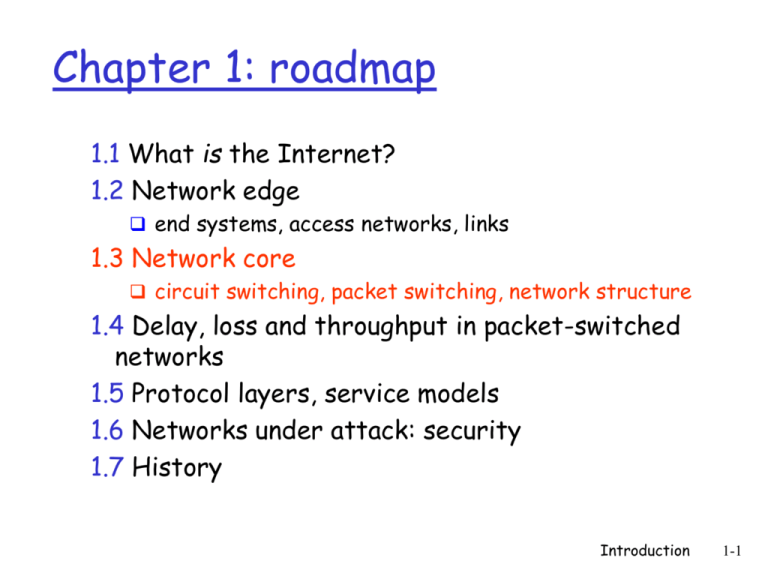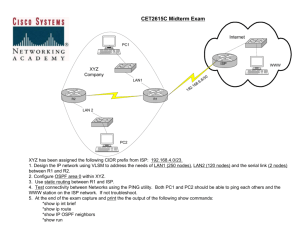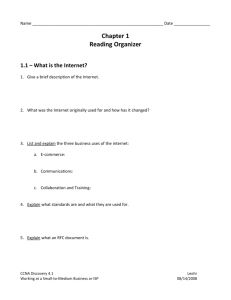Lecture 3
advertisement

Chapter 1: roadmap 1.1 What is the Internet? 1.2 Network edge end systems, access networks, links 1.3 Network core circuit switching, packet switching, network structure 1.4 Delay, loss and throughput in packet-switched networks 1.5 Protocol layers, service models 1.6 Networks under attack: security 1.7 History Introduction 1-1 The Network Core mesh of interconnected routers the fundamental question: how is data transferred through net? circuit switching: dedicated circuit per call: telephone net packet-switching: data sent thru net in discrete “chunks” Introduction 1-2 Network Core: Circuit Switching End-end resources reserved for “call” link bandwidth, switch capacity dedicated resources: no sharing circuit-like (guaranteed) performance call setup required Introduction 1-3 Circuit Switching: FDM and TDM Example: FDM 4 users frequency time TDM frequency time Introduction 1-4 Numerical example How long does it take to send a file of 640,000 bits from host A to host B over a circuit-switched network? All links are 1.536 Mbps (+8 kbps =T1; SA uses E1 @ 2048 kbps) Each link uses TDM with 24 slots/sec (E1 = 30) 500 msec to establish end-to-end circuit Let’s work it out! Introduction 1-5 Network Core: Packet Switching each end-end data stream divided into packets user A, B packets share network resources each packet uses full link bandwidth resources used as needed Bandwidth division into “pieces” Dedicated allocation Resource reservation resource contention: aggregate resource demand can exceed amount available congestion: packets queue, wait for link use store and forward: packets move one hop at a time Node receives complete packet before forwarding Introduction 1-6 Packet Switching: Statistical Multiplexing 100 Mb/s Ethernet A B statistical multiplexing C 1.5 Mb/s queue of packets waiting for output link D E Sequence of A & B packets does not have fixed pattern, bandwidth shared on demand statistical multiplexing. TDM: each host gets same slot in revolving TDM frame. Introduction 1-7 Packet-switching: store-and-forward L R takes L/R seconds to R transmit (push out) packet of L bits on to link at R bps store and forward: entire packet must arrive at router before it can be transmitted on next link delay = 3L/R (assuming zero propagation delay) R Example: L = 7.5 Mbits R = 1.5 Mbps transmission delay = 15 sec more on delay shortly … Introduction 1-8 Packet switching versus circuit switching Packet switching allows more users to use network! 1 Mb/s link each user: 100 kb/s when “active” active 10% of time circuit-switching: 10 users packet switching: with 35 users, probability > 10 active at same time is less than .0004 N users 1 Mbps link Q: how did we get value 0.0004? Introduction 1-9 Packet switching versus circuit switching Is packet switching a “slam dunk winner?” great for bursty data resource sharing simpler, no call setup excessive congestion: packet delay and loss protocols needed for reliable data transfer, congestion control Q: How to provide circuit-like behavior? bandwidth guarantees needed for audio/video apps still an unsolved problem (chapter 7) Q: human analogies of reserved resources (circuit switching) versus on-demand allocation (packet-switching)? Introduction 1-10 Internet structure: network of networks roughly hierarchical at center: “tier-1” ISPs (e.g., Verizon, Sprint, AT&T, Cable and Wireless), national/international coverage treat each other as equals Tier-1 providers interconnect (peer) privately Tier 1 ISP Tier 1 ISP Tier 1 ISP Introduction 1-11 Tier-1 ISP: e.g., Sprint POP: point-of-presence to/from backbone peering … … . … … … to/from customers Introduction 1-12 Internet structure: network of networks “Tier-2” ISPs: smaller (often regional) ISPs Connect to one or more tier-1 ISPs, possibly other tier-2 ISPs Tier-2 ISP pays tier-1 ISP for connectivity to rest of Internet tier-2 ISP is customer of tier-1 provider Tier-2 ISP Tier-2 ISP Tier 1 ISP Tier 1 ISP Tier-2 ISP Tier 1 ISP Tier-2 ISPs also peer privately with each other. Tier-2 ISP Tier-2 ISP Introduction 1-13 Internet structure: network of networks “Tier-3” ISPs and local ISPs last hop (“access”) network (closest to end systems) local ISP Local and tier3 ISPs are customers of higher tier ISPs connecting them to rest of Internet Tier 3 ISP Tier-2 ISP local ISP local ISP local ISP Tier-2 ISP Tier 1 ISP Tier 1 ISP Tier-2 ISP local local ISP ISP Tier 1 ISP Tier-2 ISP local ISP Tier-2 ISP local ISP Introduction 1-14 Internet structure: network of networks a packet passes through many networks! local ISP Tier 3 ISP Tier-2 ISP local ISP local ISP local ISP Tier-2 ISP Tier 1 ISP Tier 1 ISP Tier-2 ISP local local ISP ISP Tier 1 ISP Tier-2 ISP local ISP Tier-2 ISP local ISP Introduction 1-15



